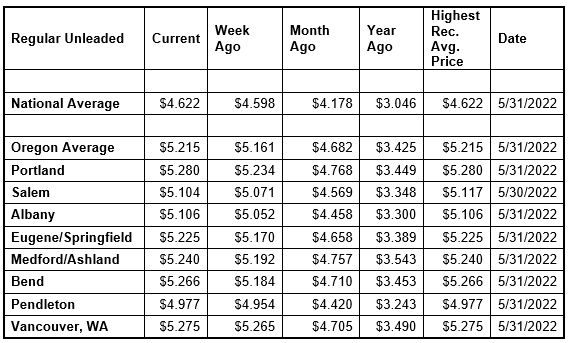
A dip in in gasoline demand provided drivers with a bit of stability at the pump, with gas prices showing smaller increases on the week. But the break could be brief. Crude oil prices have climbed above $116 per barrel due to fears of further global supply constraints caused by a European Union (EU) ban on Russian oil exports. And domestic gas demand may rise again as drivers fuel up for the summer travel season, which began this Memorial Day weekend. For the week, the national average for regular edges up two cents to $4.62 a gallon. The Oregon average adds a nickel to $5.22. These are both at record highs.

“So far, the pent-up desire to travel as we emerge from the pandemic outweighs record high pump prices for many consumers,” says Marie Dodds, public affairs director for AAA Oregon/Idaho. “However, a recent survey by AAA reveals that 67% of drivers say they would change their driving habits if gas hit $4.50 a gallon. That number rises to 75% at $5 a gallon. The Oregon average has already surpassed $5, so it remains to be seen if people will change their summer travel plans.”
All 50 states have averages above $4 a gallon and seven states, including Oregon, have averages above $5. California remains the only state with an average above $6. The national and Oregon averages continue to set new record highs almost daily, eclipsing the recent record highs set in March.
Higher crude oil prices result in higher pump prices since oil is the main ingredient in gasoline and diesel. On average, about 53% of what we pay for in a gallon of gasoline is for the price of crude oil, 12% is refining, 21% distribution and marketing, and 15% are taxes, according to the U.S. Energy Information Administration.
Crude oil prices remain elevated due to the Russian invasion of Ukraine. Russia is one of the top three oil producers in the world, behind the U.S. and Saudi Arabia, and about 25% of Europe’s oil is imported from Russia. Global supplies were already tight before the invasion and became worse with the reduction in product coming out of Russia, putting upward pressure on crude prices. A year ago, crude was around $67 per barrel compared to $116 today.
Demand for gasoline in the U.S. dipped from 9 million b/d to 8.8 million b/d, approximately 700,000 b/d lower than a year ago. Total domestic gasoline stocks also decreased by 500,000 bbl to 219.7 million bbl last week, according to the U.S. Energy Information Administration (EIA). The softening of gas demand helped minimize price increases ahead of Memorial Day. However, gas demand may spike this week after drivers took to the roads for the holiday. But pump price increases could be limited if demand slows again following the holiday weekend.
Meanwhile, the switch to the more expensive summer blend of gasoline, which usually adds seven to ten cents per gallon depending on the market, is happening now. This switchover should be complete nationwide by early June. This summer blend switch is an annual event.
Quick stats
Oregon is one of 36 states with higher prices week-over-week. Wisconsin (+11 cents) has the largest weekly increase. Texas (-3 cents) has the largest weekly decrease.
California ($6.17) is the most expensive state in the nation and is the only state to ever have an average above $6 a gallon. There are seven states, including Oregon, with averages at or above $5. Every other state and D.C. have averages at or above $4 a gallon.
The cheapest gas in the nation is in Kansas ($4.13) and Georgia ($4.14). This week no states have averages below $3 a gallon, same as a week ago. For the 73rd week in a row, no state has an average below $2 a gallon.
All 50 states and the District of Columbia have higher prices now than a month ago. The national average is 44 cents more and the Oregon average is 53 cents more than a month ago. This is the 13th-largest monthly jump in the nation. New York (+60 cents) has the largest monthly gain. Hawaii (+18 cents) has the smallest.
All 50 states and the District of Columbia have higher prices now than a year ago. Every state and D.C. have a current average that’s a dollar or more higher than a year ago. The national average is $1.58 more and the Oregon average is $1.79 more than a year ago. This is the sixth-largest yearly increase in the nation. California (+$1.96) has the biggest yearly increase. Colorado (+$1.16) has the smallest year-over-year increase.
West Coast
The West Coast region continues to have the most expensive pump prices in the nation with all seven states in the top 10. This is typical for the West Coast as this region tends to consistently have fairly tight supplies, consuming about as much gasoline as is produced.
| Rank | Region | Price on 5/31/22 | ||
| 1 | California | $6.17 | ||
| 2 | Hawaii | $5.44 | ||
| 3 | Nevada | $5.31 | ||
| 4 | Washington | $5.23 | ||
| 5 | Oregon | $5.22 | ||
| 6 | Alaska | $5.21 | ||
| 7 | Illinois | $5.00 | ||
| 8 | Arizona | $4.96 | ||
| 9 | New York | $4.93 | ||
| 10 | District of Columbia | $4.84 |
California is the most expensive state for the 71st week in a row with Hawaii, Nevada, Washington, Oregon, and Alaska rounding out the top six. Arizona is eighth. Oregon rises to fifth after spending one week at sixth.
Like most other states, all seven states in the West Coast region have week-over-week increases. California (+10 cents) has the largest weekly increase in the region. Alaska (+2 cents) has the region’s smallest weekly increase.
The refinery utilization rate on the West Coast fell from 85.4% to 83.0% for the week ending May 20. The rate has ranged between about 76% and 90% in the last year.
According to EIA’s latest weekly report, total gas stocks in the region rose from 30.05 million bbl to 30.47 million bbl.















